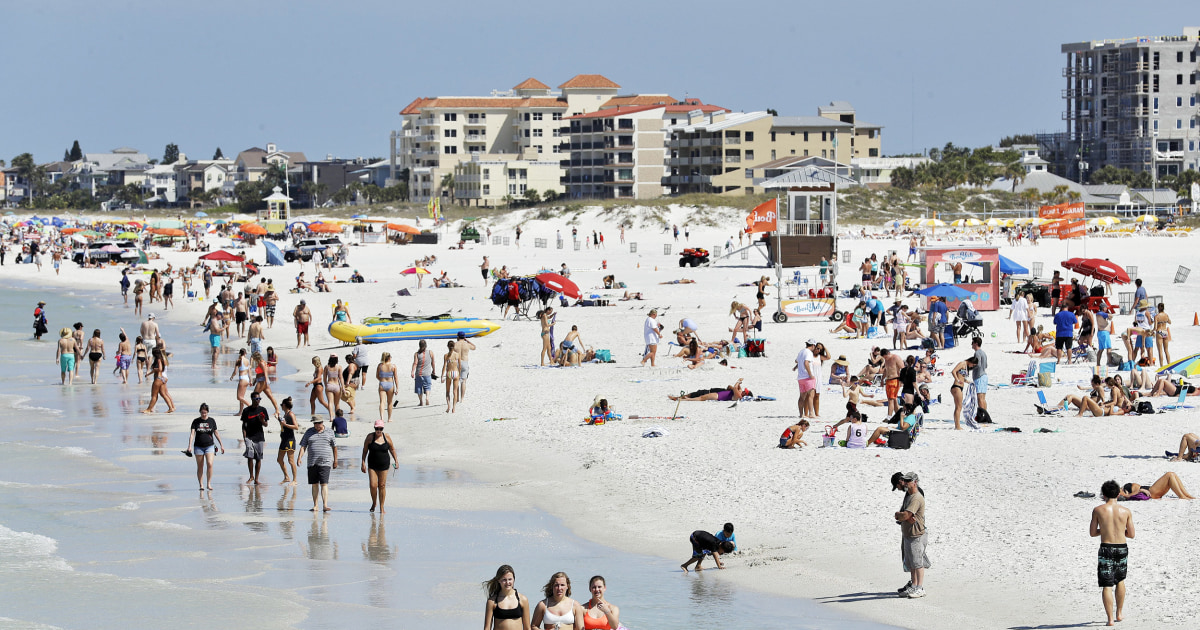The outlook for a pandemic in the U.S. continues to improve, with confirmed cases of Covid-19 falling for the sixth consecutive week and deaths declining in the past three weeks. But spring break is on the horizon, bringing with it a potential increase in travel, which makes public health experts concerned about the consequences if people do not remain vigilant.
Anxiety about spring break travel is increasing after some particularly gloomy months, when the numbers of cases, hospitalizations and deaths have increased dramatically after the holiday season. And with several strains of coronavirus circulating in the country – including some variants that are considered to be more transmissible – some experts fear that spring break could threaten recent progress.
“Any event that involves travel and people relaxing preventive measures is a concern,” said Amber D’Souza, professor of epidemiology at the Johns Hopkins Bloomberg School of Public Health.
D’Souza said the patterns that emerged last year demonstrate how much the path of the pandemic is driven by behavioral changes. For example, as places experience severe outbreaks, people generally respond by staying at home, practicing social detachment and wearing masks. But as the situation improves and restrictions are lifted, many tend to become more relaxed, which can lead to new outbreaks.
“This is exactly what we saw after Thanksgiving and Christmas,” she said. “It is a continuous cycle and an ongoing concern.”
Last March, the United States was just beginning to emerge as the new center of the pandemic, and states struggled to contain the spread of the virus last year. On Sunday, the US reached 500,000 deaths from Covid-19, eclipsing the death toll of all other countries.
Although the number of cases, hospitalizations and deaths has declined in recent weeks, the United States still averages more than 1,000 deaths per day from Covid-19.
“Rates have dropped,” said D’Souza, “but they are still not what we would consider low. We are only much better than we were a month ago.”
D’Souza said some spring break trips last year led to local outbreaks, but the real impact of the spring trip will never be known because the data has not been tracked nationally. Florida Governor Ron DeSantis, in particular, was heavily criticized for refusing to close beaches last March, even when the coronavirus was spreading in the state.
This year, some officials are enacting new restrictions ahead of spring break. Miami Beach is introducing a midnight curfew in the entertainment district, and alcohol is prohibited on the beach.
“If you’re coming here because you think it’s a anything-goes place, please turn around or go somewhere else,” Mayor Dan Gelber told WPLG-TV on Monday.
At the same time, US airports report steady increases in passenger numbers compared to last year, although the level of travel in the U.S. remains significantly lower overall.
Clayton Reid, CEO of travel marketing company MMGY Global, said the recovery started last summer and is expected to continue.
“We expect a big return from travel in the spring and summer,” he said, adding that leisure travel, in particular, is expected to increase dramatically when vaccines are available to more people.
In the meantime, the Centers for Disease Control and Prevention have advised Americans to avoid unnecessary travel.
But if people plan to flee in the spring, there are ways to reduce the risks, said Dr. Joseph Khabbaza, a specialist in pulmonary medicine and intensive care at the Cleveland Clinic.
“In general, driving elsewhere will always be safer than having to be at airports or bus terminals or riding a train with other people,” he said.
Outdoor experiences, such as camping and visiting state or national parks, are also less risky, he said. But regardless of destination, Khabbaza and D’Souza said, it is important to avoid large meetings, wear masks and practice social detachment.
“You want to be masked or find a place far away,” said D’Souza. “If you’re sitting in a crowded bar with a lot of unmasked people, this is definitely a potential source of transmission.”
D’Souza said she acknowledged that people may be dealing with pandemic fatigue and looking for an escape, especially as the weather warms up, but she asked people to be cautious and assess the risks.
“If people don’t travel, this is the safest thing,” she said. “But if people choose to travel, it is important to be smart.”
